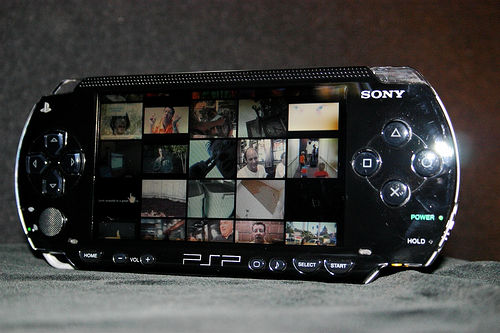I've been starting to get a little gravity with my last post on the future portability of media on
mmeiser.com (also posted on
evilvlog.com) and while I'm sure most are getting what the hell I was blathering about, the responses are not all that clear.
This is in response to
unmediated and
Marc's Voice: Hey look - there's Eric Rice. First, Here's Kenyata's post on unmediated. This contains his comments as well as Mark Canter's original post.
When I first saw this picture - i actually thought it was working code:

But then Michael Meiser discloses:
"Eric Rice posts this picture of the Sony PSP loaded up edge to edge with thumbnails of videos theoretically just a click away. It's not really there, but it is a vision of what could be."Then I see that Michael is complaining that the PSP doesn't have enough memory.
Dude - let me tell yah about the time we convinced Phillips to DOUBLE the amount of RAM it was defining for CD-I - from 500k up to a whopping 1M of RAM! That was back in 1989.
There will NEVER be enough RAM. My XP machine running 512M of RAM is constantly swapping and running out. RAM usage is like gas in a vacuum.
(I'd love to see someone get a PSP vogbrowser going sometime soon, as I've been working on PSP-friendly CSS and Javascript version of Rocketboom for a couple of weeks now. Hey Peter: I could've sworn you had a working demo of something like this going on somewhere. -kc.)
First, With all do respect to Mark, this post is not about the RAM memory, but the PSP does tap out at 1gig in flash memory right now, and that won't hold to much video footage. Sure it's enough for basic usage considering video blog videos are usually less than 30mb, but a movie is about 700mb and that doesn't leave room for to many vlogs, not to mention other content people may have on their PSP like mp3's. I'd also like to point out in the near future 4gb flash cards should be out and affordable if not already, and the PSP may well support future flash cards that are in the 10's of gigabytes. Yeah, so, memory is a small issue, but it's not the most important issue.
Second, The interface seen in the PSP IS working thanks to Peter of Mefeedia and Eric Rice of audioblogs.com. My apologies to Eric and Peter if I confused the issue. They're both doing amazing things. My point is this interface is simple not easy enough for the everyday user. Sure you could argue you could teach your mom to use it, and I'm sure she could, but there's no one save a few media geeks like myself who are ever going to even play around with this interface let alone use it on a regular basis. It's a novelty. A very cool novelty, but still a novelty. It's simply "not ready for prime time". Specifically:
1) You need to type the url into the PSP or otherwise have it bookmarked. Fair enough, but it's a few clicks at the least.
2) Then after when you click on an thumbnail image you are taken to the post about the video, not the video itself
3) You then have to browse through the post to find the video. It does not simply play.
4) Once you do find the direct link to the video (if you do find the link to the video as they are not always contained in the post) you then have to click on the link and the video will download to the PSP for later viewing in the media player. It does not stream.
5) Provided the video is in the right format, you can browse through the PSP and find the video on the flash card and play it.
Now, I may be wrong on one or two of the specifics, but the overall outcome is obvious. I suspect noone besides a few of us media geeks would consider it enough "fun" to repeat on a regular basis. You would in fact spend more time getting the videos onto your PSP then actually watching them. It's got huge whopping way to go in accessibility and usability. If you continue reading I'll lay it out for you right here and now as I've talked fairly extensively about this with certain people whom have the ability to bring this vision to fruition, if not fully then in part.
The basic gist of it is the videos need to be delivered to the PSP via an RSS enabled mechanism without any attention by the user so that when the user turns on the PSP and essentially hits the play button they're watching the latest greatest videos from their friends or family.
In order to accomplish this we will need an RSS aggregator on the PSP that downloads videos from the subscribed feeds and the meta information automatically without the constant attention of the owner. The means the PSP itself needs to auto-handshake with any trusted or open wifi point so that this aggregation can happen without any attention from the user whatsoever.
The is another part, but this is the easy part and I think some people are already working on it. For the sake of simplicity we need to offload the subscription management to a webservice like Odeo (but for video) or more likely Mefeedia or another video blogging webservice. By offloading the subscription management from the PSP to the webservice only a single RSS feed need be put into the PSP. Through this single RSS feed Odeo, Mefeedia or other said webservice can use this unique RSS feed to deliver all the subscriptions content to the PSP. This removes a tremendous amount of PSP based complexity allowing you to manage your PSP subscriptions from any computer anytime.
Odeo is the only one I know that uses this mechanism as of yet. They employ a single unique RSS feed for each users and push all subscribed feeds through the single feed to the PSP. Thus making subscription management independent of the device / aggregator and moving it to the webservice.
In addition to this being independent of the aggregator it has the very important added bonus of enabling one click subscriptions and additionally the queuing of individual content (more on that later). Since you no longer need to get every feed link into the aggregator (just the single feed the Odeo-like webservice creates for you) you can enable one click subscription from any individuals video blog to the webservice. To reiterate you're basically moving the subscription management out of the aggregator and into the webservice. This transparently works with every aggregator already out there including iTunes, iPodder, FireANT and a half dozen other video aggregators.
There are many other advantages to. For one its got a nice migration curve to. I, the end user can slowly move my subscriptions management out of itunes and FireANT and into a webservice like Odeo giving me (the end user) the additional advantage of being able to switch between any aggregator anytime, manage my subscriptions from any computer, and have the same subscriptions on any aggregator wether at work, at home, or out and about with my PSP-like device.
Imagine getting all the same videos at work, home or on your PSP without any syncing.
But that's not all...
(I feel like an infomercial sales pitch guy selling you on server side subscription management)
If you act now you'll also get
single click qeueing!
About the queuing. I mentioned this in my last post, but there were many questions so I'll go into it more thoroughly here. I think this will be the next generation of inter-mediation of content. You can think of this as part of the "next generation directory", or "directory 2.0" but that would be to limited. This takes the directory beyond being a directory and turns it into a "marketplace" for video content. I'll write more on the marketplace concept later. It's a subject that's going to require another post.
Now back to queuing. Currently while browsing around on Odeo site you can with a single click add any piece of content to you queue so it will be downloaded to your computer / device next time it loads. Essentially this is "beyond the subscription model". To put it in the terms that made sense to me instead of subscribing to just the Ipod Lounge podcast, you can do a search or browse by the "ipod" tag and queue up individual episodes from any podcast feed about the iPod with a single click even though the podcast feeds themselves might not be specific to the iPod. That's getting beyond the subscription model. Currently there's no way to do this. It's sort of like browsing tags on technoratti and being able to search just for podcasts. In fact maybe Technoratti will have this feature in the future, though I doubt Dave Sifry and any of the google crew is reading this. Such future searching and single click queuing will allow for the user to create a much more controlled and therefore enjoyable experience.
To summarize, being able to search or browse podcast content by tags and queue individual pieces of content with a single click is monstrous "directory 2.0" type intermediation. Truly "beyond subscriptions" as I like to say. At this point it's is not really a directory at all, but starting to become a true "marketplace".
But wait there's more! If you act now....
Once such a service is created by Odeo, Mefeedia, or another web service provider plugins can be created for Moveabletype, Wordpress, and even a little crafty code that can be inserted into a Blogger template that will allow video bloggers to not only put a single click subscription link in their video blog but also add a "queue it" button automatically on every video blog post, perhaps right next to the video or perhaps by the permalink. It's only a matter of passing certain information contained in the blog post to Mefeedia, Odeo, or whatever webservice is first to offer it.
But the advantages just keep coming!
Act now and you'll not only get aggregator independent subscription management, single click subscriptions and single click queuing, but with a handy
bookmarklet it is entirely possible to enable single click queuing and subscriptions from
any page on the web!.
Yes, it's true!
Imagine your users being able to click a single button and add any video on any page on the web to their PSP-like device!
You mean with a single click I could put any video on the web on my portable video player?
Yes that's right, by creating a handy little javascript "bookmarklet" a webservice provider like Mefeedia or Odeo can not only enable single click queuing for their users, but with a little nifty Javascript they can quickly identify and video enclosed (or not enclosed) in any page on the web and add it to your queue so your portable video player can download it. Tricky? Not any more than any self righteous javascript developer can handle.
In summary... It's time to get beyond all the video blogging (and podcasting) 1.0 style directories. They were a great start, but it's time to start building 2.0 style
marketplaces where monetization can happen (more on monetization later). This can be done by,
1) getting beyond subscriptions
2) enabling the consumption of individual pieces of micro-content
The cornerstone of these new webservices marketplaces will be...
1) aggregator independent, server side subscription management
2) one-click subscriptions
3) one-click queuing
4) and of course all that good searching, browsing and tagging goodness you've come to expect from del.icio.us, flickr and other web 2.0 type webservices. Don't worry I'm already working on another post to explain this marketplace idea more thoroughly we'll get into marketplaces and monetization yet.
In summary... PSP awesome, it could use a little more memory but that's not what's important. What we need is to be able to develop an RSS media aggregator for it and I don't think Sony has an API. Perhaps there are some interested linux lovers. What we can do in the meantime is.
a) create better directories with one-click subscription among many other things... to turn them into more publicly accessible marketplaces.
b) Come up with standards and specifications for what we need in a piece of hardware / software to enable videos and audio podcasts to be auto-magically aggregated from the web directly to a portable device (sans Apple's "hub"). If I had a million dollars I'd OEM one, but I don't think anyone like Sony gives a crap, they could probably care less about our little democratization of media because it makes far more sense to sell us all Hollywood than allow us to make and share our own media. After all it took them untill this year to finally come out with an mp3 player. Perhaps a more progressive hardware company like Creative is listening.
Disclaimer:
Now, if I was a real bastard I'd patent all this stuff, but first of all Odeo is already on it, if not in the entirety, then at least they have a partial vision of it. Second, my ideas are hopefully the exact opposite of "bastard ideas". I'm sharing this because idea's do have mothers and fathers, to patent ideas like these is to simultaneously take credit for the ideas while denying the do credit of those people whom they came from. Hopefully by sharing my ideas they'll make sweet idea lovin' and spawn hundreds and thousands of other baby ideas (or at least one or two) which will hence keep going forth and multiplying like a big beautiful "idea virus". Yummy. That's what good ideas do, if they're good. And hopefully some of these ideas or those they spawn will actually be implemented in real live tools I'll get to use. Wow! Won't that be neat! So, that is my ROI, and it's a damn good ROI. (But hopefully someone somewhere will one day recognize my brilliant ideas and pay me money to do other brilliant things in this area because as the saying goes I can dance to it but I can't eat it. That and it's time to get the lead out and monetize this schite! Yeah, I'm talking to you. You the tinkering with some cool webservice I may have mention. You the guys working on the directories and pretty much anyone developing infrastructure in the vlog-o-sphere or podcast-o-phere. Including but not limited to FireANT, Blip.tv, Audioblogs.com, Odeo, Brightcove, Mefeedia, Ourmedia and at least a dozen others. Let's get this medialicious party started.
More on next generation video blogging marketplaces later, today perhaps.
Cheers! :)



